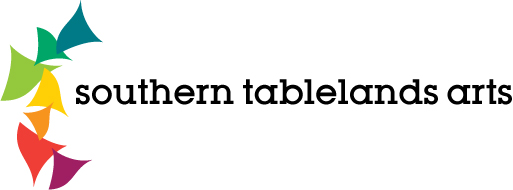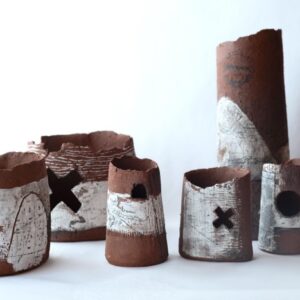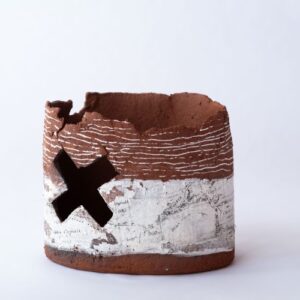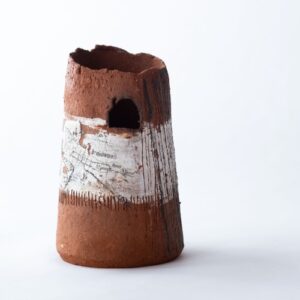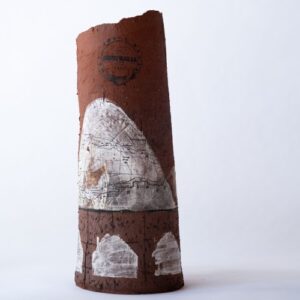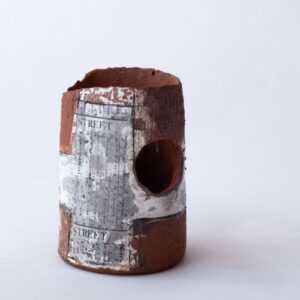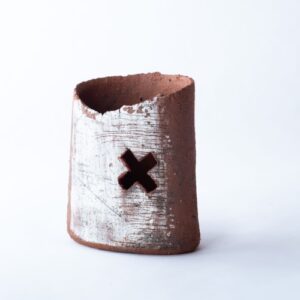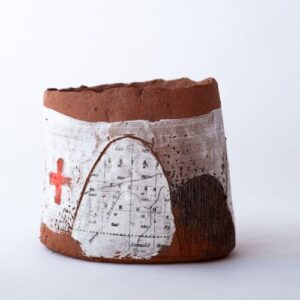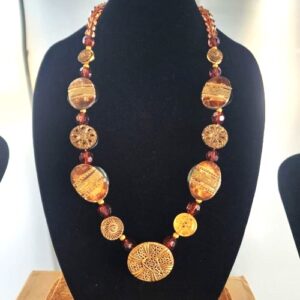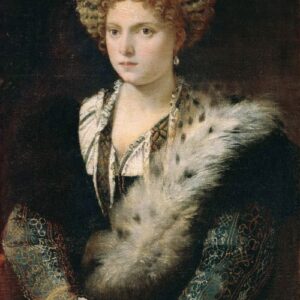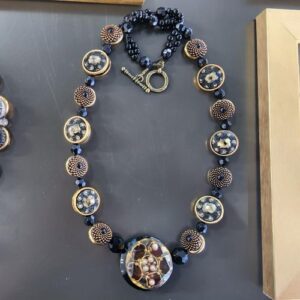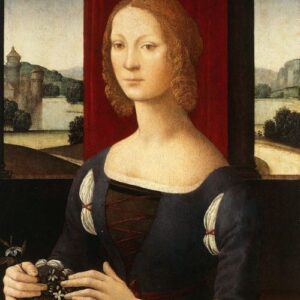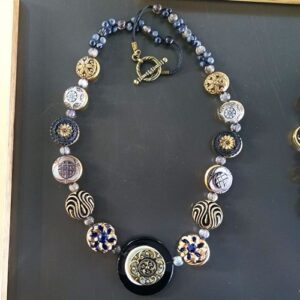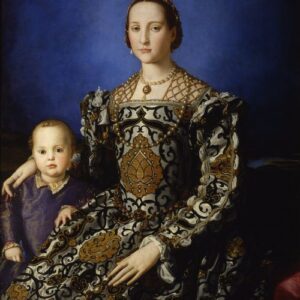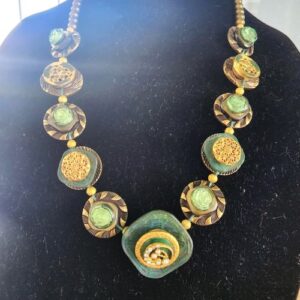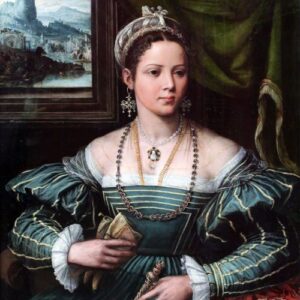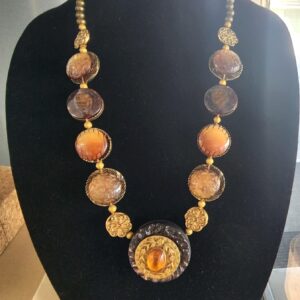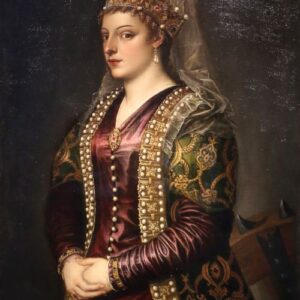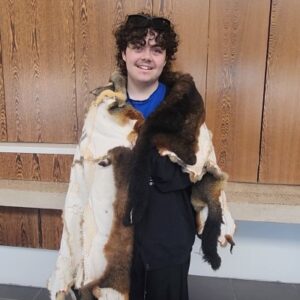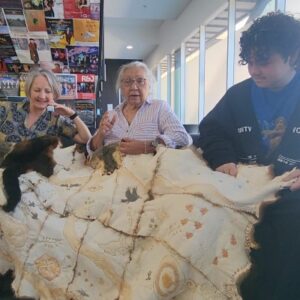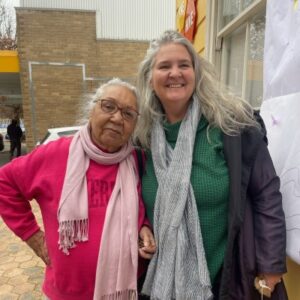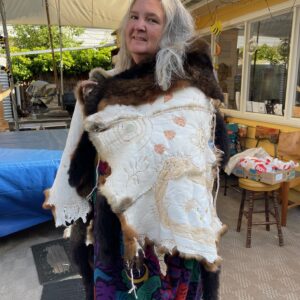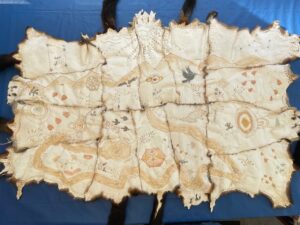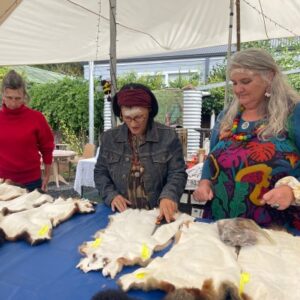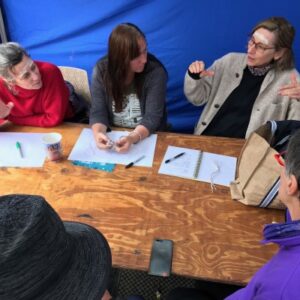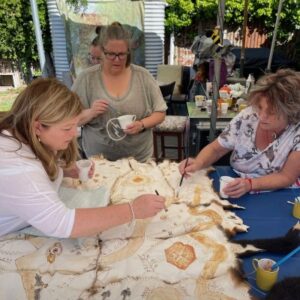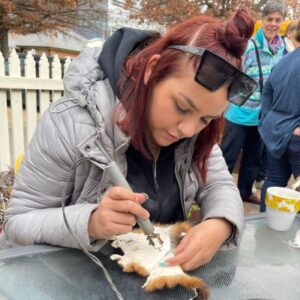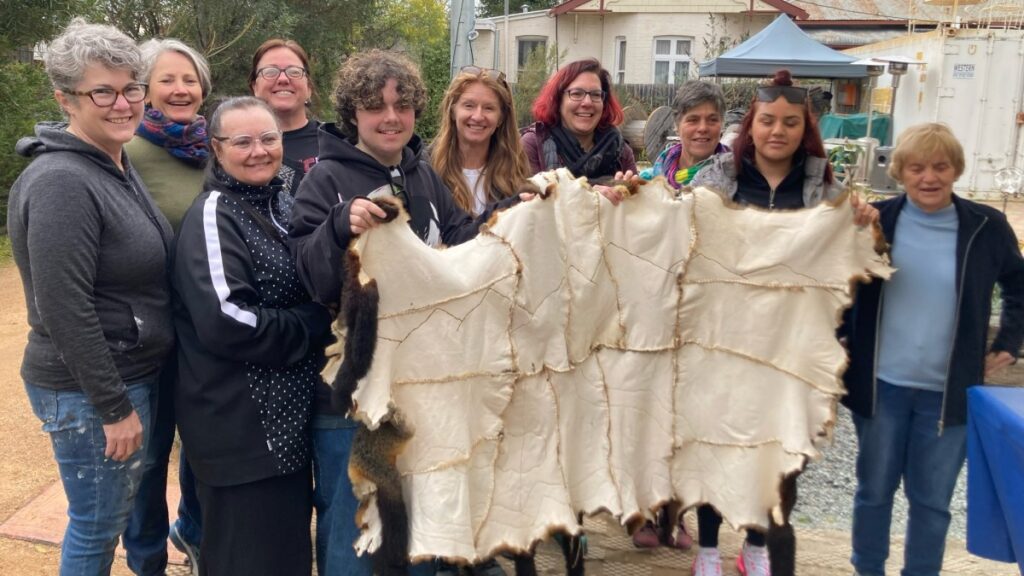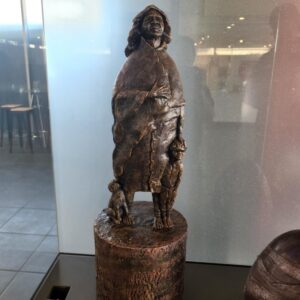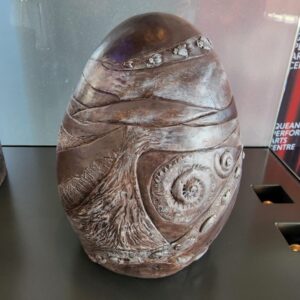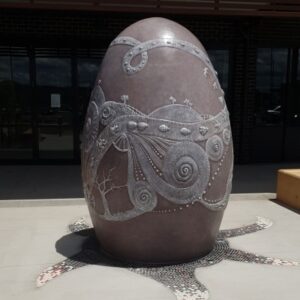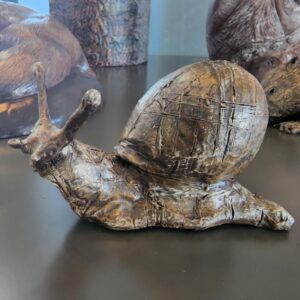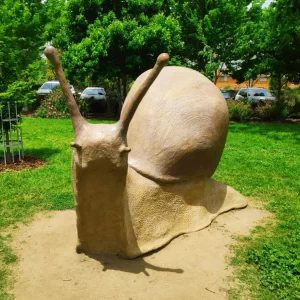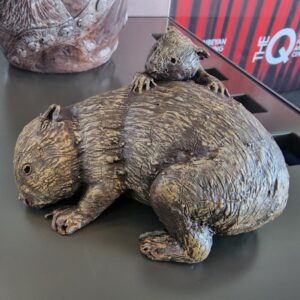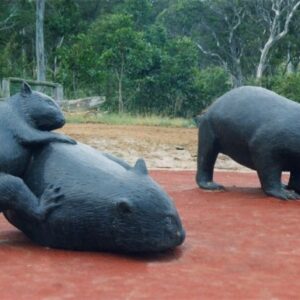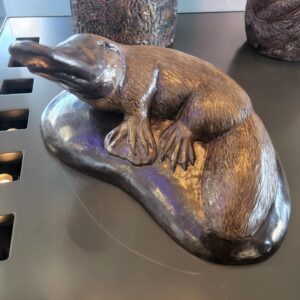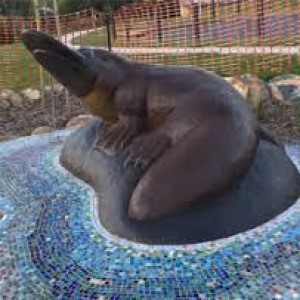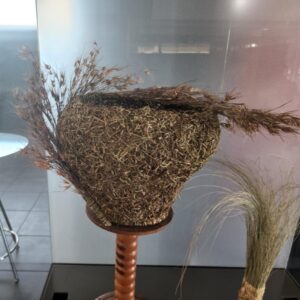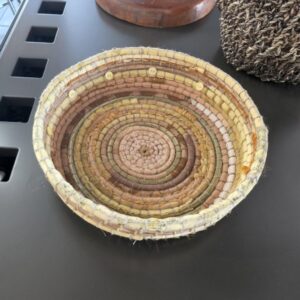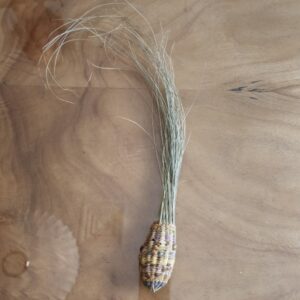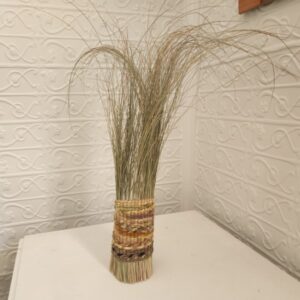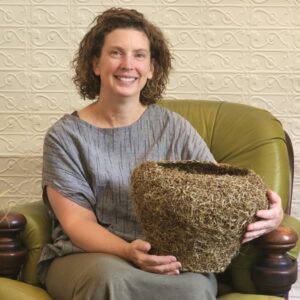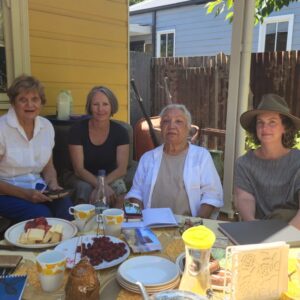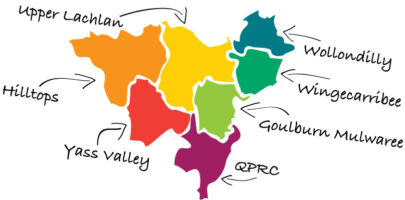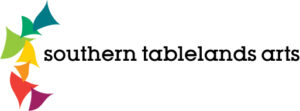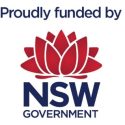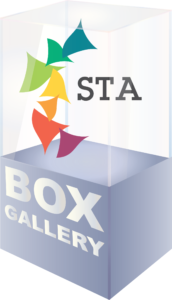 The STA BOX Gallery @ THE Q
The STA BOX Gallery @ THE Q
The Q Performing Arts Centre is the home of the STA Box Gallery in Queanbeyan Palerang. Enjoy the online gallery below and visit STA Box Gallery QPRC at The Q at 253 Crawford St, Queanbeyan.
BOX Gallery exhibitions are available to STA Members on application. Members can apply for an exhibition in one or more BOX Galleries. If you would like to register an interest in a BOX Gallery exhibition email us for more information.
Find out more about the STA Box Gallery Project
Tika Robinson, Spring 2025
Tika presents ceramic fungus forms and the effect that different clay, glaze and inks create in the works. She is interested in ideas such as life and death, decay and growth. Exploring the decay to regenerative process that fungi produce. Tika looks at the contrast of humans and nature delving into the depths of the natural ecosystems. She studies the ecosystems of mycelia networks that connect multiple organisms and fungi underground. These networks highlight the connection and distribution of the world’s regeneration.
Tika has won multiple awards including the People’s Choice Award (indoors) in Sculpture Bermagui 2025. Emerging Artist Award in Sculpture for Clyde 2024, the Beach Hotel Award in Sculpture Bermagui 2024, and awarded Highly Commended in the National Contemporary Art Prize 2024. Tika grew up on a cattle and truffle farm near Bungendore in QPRC and graduated with honours from UNSW.
In addition to her creative practice Tika is the Director of Water Through Reeds gallery in Bungendore. The gallery runs a rich exhibition program showcasing a variety of work with an emphasis on local artists.
Waiting Fungi $2,500
Mushrooms $20 small & $30 medium
Enquiries directly to the artist
Drop into Water through Reeds Gallery at 11 Gibraltar St, Bungendore. www.waterthroughreeds.com.au and instagram @waterthroughreedsgallery
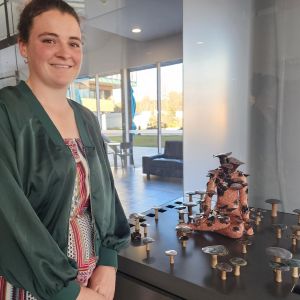
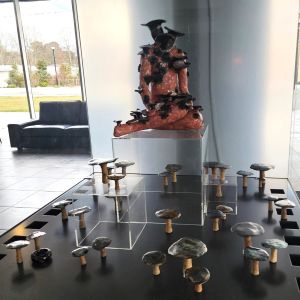
Previous STA Box Gallery QRPC Exhibitions
Conviction by Bill Dorman, Winter 2025
I call on the provenance of the vessel’s material – the original brass of Goulburn’s courthouse roof – to critique the systems that have both historically and contemporaneously created and controlled a dominant narrative of lawfulness. In this work I am extending my sculptural investigations of empathy for displaced and subjugated peoples.
Find out more about Bill at his website www.billdorman.com.au
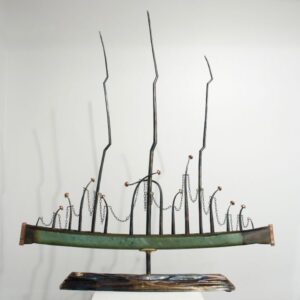
Conviction 2024
Old brass from the original Goulburn Courthouse roof dome, steel, brass, copper,
1070mm wide- 1220mm high- 140mm deep
$5800
Enquiries
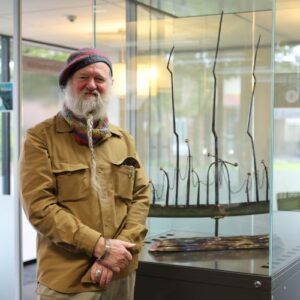
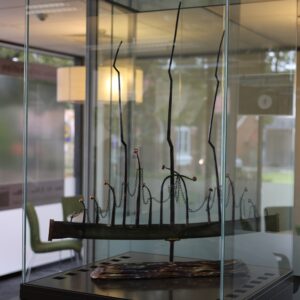
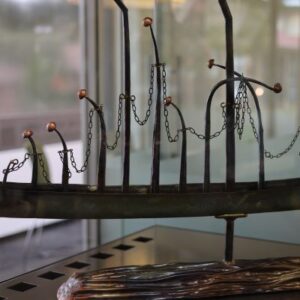
The Gift of Despair by Corinne Dany Autumn 2025
As artists we are always asked ‘where do you get your ideas from’ or ‘what made you make this piece?’
Well, it’s rare that I can recall the exact moment an idea forms in my head. I have a funny example of one, and I have a not so funny one to tell you about.
The funny one involves nudity and a hot shower and a cranky daughter. One evening I was washing my hair, scrubbing and splashing along to my singing (coz the acoustics are brilliant in that room). Anyway, after the rinse and repeat ritual, I blinked my eyes open and low and behold I saw a shape on the shower screen door! It was a sort of seahorse but not quite kind of shape! Well I leant over and with my trusty water pencil, and drew two huge ears on that shape and voila! It became a seahare! I screamed out to my daughter to get my phone, frozen still in case another movement would splash away my sketch. She obliged very unwillingly, eyes firmly shut and arms outstretched! But we got the shot!
My sketch became the piece called The Seahare, which became one of my favourite watercolours in the exhibition I was working on at the time.
Fast forward to July 21st of this year, I returned from a fabulous day at the Bowral Long Lunch where I managed to raise 3k for the wonderful charity Bowral District Children’s Foundation. I was proud as punch as I had never created something that raised that amount before! And I met my beautiful collector who bought the painting, Rebecca from Bowral Fine Jewellery.
I came home on a high only to find my beautiful Shilo Shepherd, Honey, collapsing in the back yard. She was almost 13 and was my constant companion. I called her my shadow and anyone who has a German Shepherd knows what I mean. They follow you when you have food, when you’re ready to go out, when you are happy or sad. Even when you are peeing!!
We lost Honey that night. I lost my shadow and a beautiful soul. I have not been able to shake this one off. We have had beautiful pets in the past but sometimes one stands out and when they leave, it cuts out a massive hole right in the middle of your house…. and heart.
But now that the Bowral Long Lunch event was over it was time for me to create something for The STA Box Gallery. I was in bed for day 2 with a bad cold that overcame me while I was grieving, listening to Nick Cave in conversation with Richard Fidler as my eyes were too puffy to watch any YouTube! While I was listening, I had a clear as day vision splash before me, just like in the shower! The vision was of a sculpture of me wrapped in grief letting go of my beautiful Honey as she was taken away from me by Mother Nature… and it brought me to tears. I second guessed whether I should create this sculpture for the box gallery.. it’s not the happiest of themes.. but the vision stayed with me and drove me to the studio… I wanted to create something that would honour our Honey. Making anything else would feel so trivial.
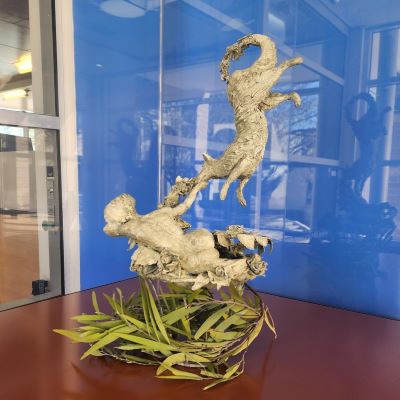
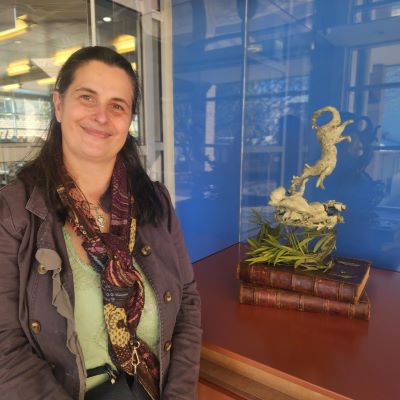
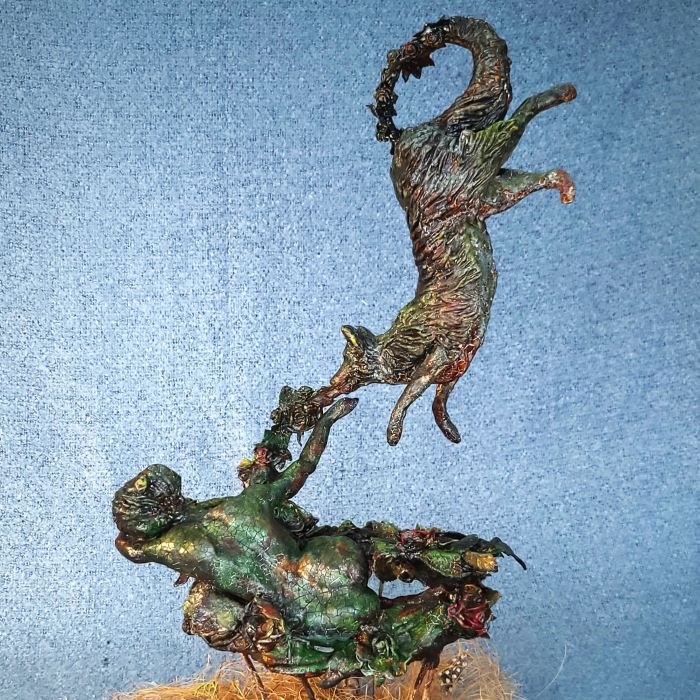
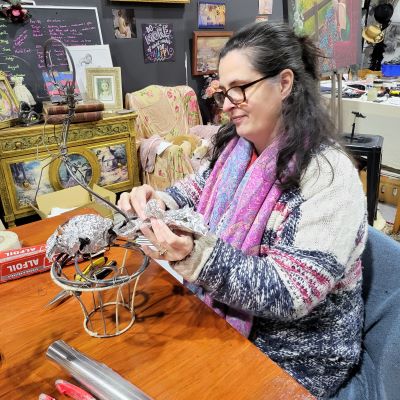
The Gift of Despair by Corinne Dany
$2100 sales inqueries directly to the artist [email protected]
This unique work was created especially for the STA Box Gallery. Books used as plinth are for display only and not for sale.
Connect to the Artist corinnedany.com
Worth a follow @corinnedanyartist
Erased: Lost. by Lea Durie, Summer 2024
Ceramic works by Lea Durie from Braidwood.
I create works using ceramics, found materials, textiles and paper. My practice is concerned with our natural and built environment and how we can bring care to the forefront of our thinking. I am interested in places and materiality that is connected to that place, sometimes working with wild clay. Working with the materials of a place I explore the impact of extreme weather and a changing climate.
I explore land, maps and changes to the landscape through land use, with climate change as a point of reference.
Find out more about Lea at her website leadurieceramics.com.
Instagram @lea_durie and facebook.com/lea.durie
Purchase enquires are directly to the Artist [email protected]
Excised 2024
Wild Braidwood Clay, Stoneware Clay, slips and underglaze 15 x 17 x 11 cm
$300
Enquiries
House 2024.
Wild Braidwood Clay, Stoneware Clay, slips and underglaze 14x 9 x 9 cm
$200
Enquiries
Town 2024
Wild Braidwood Clay, Stoneware Clay, slips, decals and underglaze
30 x 12 x 12 cm
$450
Enquiries
Gaping 2024
Wild Braidwood Clay, Stoneware Clay, slips, decal and underglaze
12 x 9 x 9 cm
$200
Enquiries
Cutout 2024
Wild Braidwood Clay, Stoneware Clay, slips and underglaze
12 x 10 x 6 cm
$200
Enquiries
Landmarks 2024
Wild Braidwood Clay, Stoneware Clay, slips and underglaze
5 x 16 x 13 cm
$300
Enquiries
Necklaces they might have worn by Cathy Hutton
These necklaces created from antique and vintage buttons are my tribute to the magnificent creativity of the sixteenth century Italian Renaissance, as shown in the exquisite fabrics produced in the workshops of Florence and Venice and in the precious buttons designed and handmade by master craftsmen.
Although for many years I have been making an annual trip to Northern Italy to search out the rare and unusual buttons that can still be found in the local antique markets, I only recently realised that the glass and metal buttons that were the real treasures of my collection would perfectly complement the gorgeous antique fabrics that I had seen in costume museums such as the Museo del Tessuto in Prato and the Museo di Storia del Tessuto e del Costume in Venice.
I then selected from the many portraits of Renaissance women dressed in their finery and painted by artists such as Titian and Bronzino those that would inspire me to create the necklaces that the women portrayed might have worn with their sumptuous dresses.
Although the buttons I have used to create these necklaces were made centuries later, they in turn have been inspired by the designs created by the jewellers and goldsmiths of the sixteenth century.
Cathy operates under the name Vintage Caterina and can be contacted about any of these exquisite pieces or to discuss bespoke commissions via email; [email protected]
Previous STA Box Gallery QRPC Exhibitions
Artemis Anthropocene by J A Cornish, Winter 2024
Plastic Mannequin, Papier Mache – telephone books, newspaper, PVA Glue; Eucalyptus Scoparia Branches, Eucalypt Angophora Costata Bark; Woodchips from Pine and Cypress; Charcoal; Magpie Nest – natural materials & plastic waste; Fairy Wren’s Nest – natural materials; Paper Wasp Nest – natural materials.
‘Artemis …’ is an obvious comment on waste and the overuse and destruction of natural resources, also the proliferation of plastic waste in our environment and the affect it has on our health and the health of the natural world. She’s made from a plastic mannequin covered in papier-mâché from telephone books and newspaper, specifically, the Sydney Morning Herald’s Good Weekend and News Review, the sections I read. I’ve got a love-hate relationship with paper, especially newspaper and magazines; I love to read, I hate that often what I’m reading was once a tree. The newspaper is mostly cut into leaves, and layered on the mannequin like they were drawn to her, almost in an effort to remake themselves as trees again.
There are also butterflies, a bee (made from multiple cut out bees), a dragonfly, and two crescent Moons cut from the newspaper – I actually wanted to do more and create a fresco across her upper chest, but cutting tiny exact insects ran into time I didn’t have (for now). Bees were chosen because they were sacred to Artemis and have been identified as the single most important species on earth. The butterflies and dragonfly are a nod to my Welsh ancestors and sister (who loves dragonflies), and Artemis wore a crescent moon as a crown. The leaves are also like shoals of fish, and I like this Homeric Hymn to Artemis traveling across the land: “The tops of the high mountains tremble and the tangled wood echoes awesomely with the outcry of beasts: earth quakes and the sea also where fishes shoal.” One of the 12 Olympian Gods, Artemis is Goddess of waters and rivers, her twin is the sun God Apollo, and Poseidon God of the ocean was her uncle.
As a nerdy child reading Greek Myths and Legends, Artemis was a favourite “…the first nymph, a goddess of free nature. She is an independent free woman, and she doesn’t need any partner…” Amongst other things, she’s the Goddess of the wilderness, wild animals, nature, vegetation: “…In bucolic (pastoral) songs the image of [Artemis] was discovered in bundles of leaves or dry sticks” – hence my sticks and branches.
The single most important piece in the sculpture is the magpies’ nest. Finding it and seeing that it was created by these brilliant birds from so much plastic waste broke my heart. I found the nest, which had blown down from a huge eucalypt in a storm, in 2018. Eight or so years of drought had denuded the local gardens and wild grasses and I suspect the Magpies had to scavenge far and wide to find any nesting materials, including the plastic packing tape, the spines of a plastic fence, the plastic netting and even the very large wood and wire mobile I’d created which they stole from my garden, a block from where I’d found the nest. The wire was unwound from some of the props in the mobile and wound thorough the nest. The thin fencing wire remains in the nest, but I had to remove the rest of the mobile as it was too heavy for my Artemis’ branches – quite the circle of creation.
And as for plastic and how it relates to Artemis, Goddess of the hunt, wilderness, reproduction, and women’s health? “Microplastics (MPs) and nanoplastics (NPs) are emergent pollutants, which have sparked widespread concern. They can infiltrate the body via ingestion, inhalation, and cutaneous contact (they can rub off by touch). As such, there is a general worry that MPs/NPs may have an impact on human health in addition to the environmental issues they engender… With the detection of MPs/NPs in fetal [sic.] compartment and the prevalence of infertility, an increasing number of studies have put an emphasis on their reproductive toxicity in female[s]. Moreover, MPs/NPs have the potential to interact with other contaminants, thus enhancing or diminishing the combined toxicity.” ** Plastic weakens Magpie nests too.
In some First Nations Lore, the Magpie is a messenger and guide.
*All quotes from Wikipedia, except: **Toxicity of microplastics and nanoplastics: invisible killers of female fertility and offspring health – National Library of Medicine. America. Published 2023 Aug 28. Yuli Geng, 1 Zhuo Liu, et al.
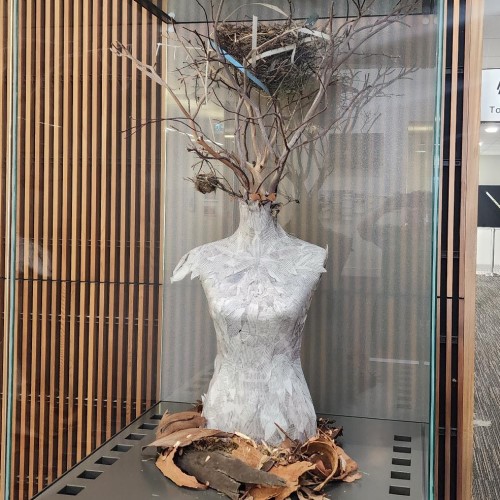
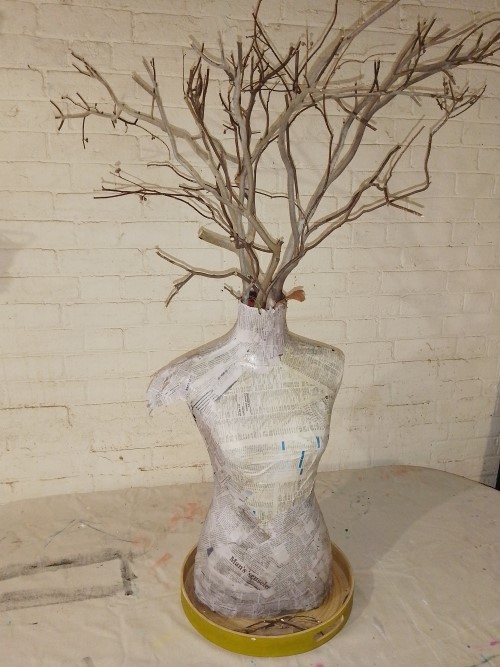
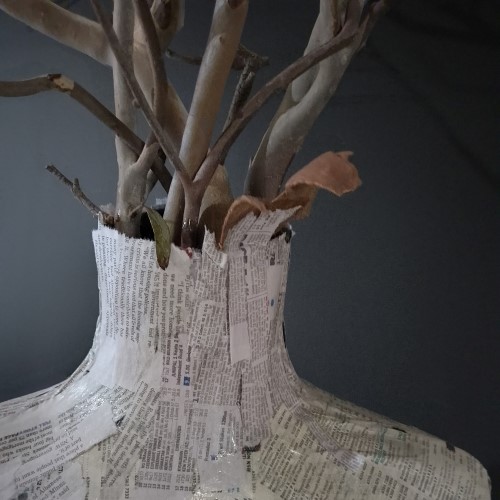
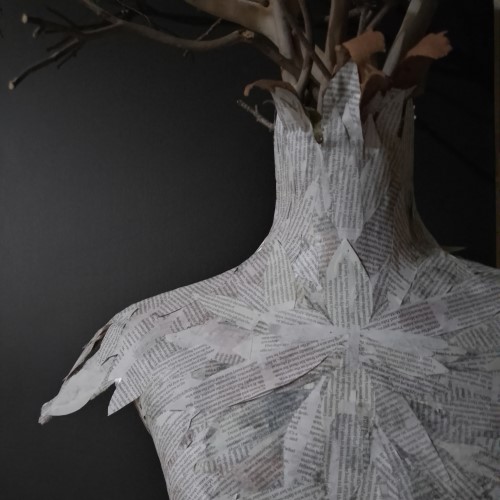
Belonging, Possum Skin Blanket
Summer 2023 & Autumn 2024
An exhibition of the Possum Skin Blanket made with Dr Matilda House and the community through a series of workshops and gatherings at the Queanbeyan Hive across 2023.
Aunty Dr Matilda House is a Ngambri/Wiradjuri Elder who led the process to share the ancient tradition of making blankets from Possum Skins with community members who participated in a series of workshops. Designing the pattern of the skins, trimming, sewing and then decorating the skin side of the cloak with poker work designs that tell rich and complex stories of belonging and connection to Country.
One of the most important stories to emerge and be incorporated into the blanket was that of Tom and his mother who are reconnecting to their First Nations heritage as part of the legacy of the Stolen Generations. Aunty Matilda named the cloak ‘Belonging’ in Tom’s honour to acknowledge this important reconnection.
The workshops were facilitated by Amanda Renolds (Stella Stories) who brought her deep knowledge of making Possum Skin blankets to support Matilda through the multi workshop process. The possum skins were sourced from New Zealand to create the cloak.
The workshops were developed by Helen Ferguson at the Queanbeyan Hive and Sue Jarvis from The Rotary Club of Jerrabomberra who were both there every step of the journey.
The project was supported by a grant through CASP (the Country Arts Support Program) administered by STA.
Previous STA Box Gallery Exhibitions at the Q
Sculptures by Walter Brecely Spring 23
Artist Walter Brecely’s diverse education, spanning Fine Arts at Illawarra Institute of Technology (1993-95) and a Bachelor of Creative Arts majoring in Sculpture from University of Wollongong (2000), complements his proficiency in engraving, stone setting, and metal casting.
His work has earned acclaim including the 2008 Goulburn Regional Art Award, and finalist positions in several art prizes including the Woollahra Small Sculpture Prize and the Deakin University Contemporary Small Sculpture Prize. His latest accolade is the 2023 BOCCA Sculpture Prize. Walter was also the Lead Illustrator for the VR project Inanimate Alice: Perpetual Nomads from 2016 to 2018, a coproduction funded by Screen Australia and the Canada Media Fund. The project secured the 2020 Reader’s Choice Prize at Woollahra Digital Literary Awards and an Honourable Mention in 2017’s Turn On Digital Literature Prize.
Contact Walter directly through his website to chat about any of the works. All are for sale. walterbrecely.com Facebook:@BrecelyStudios and Instagram:@walterbrecely
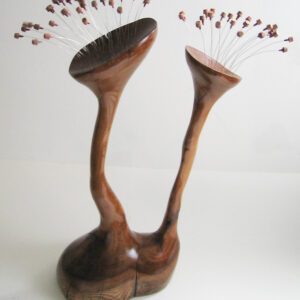
Trembler, 2014.
Wood (elm), stainless steel, recycled diesel engine filters.
Enquiries
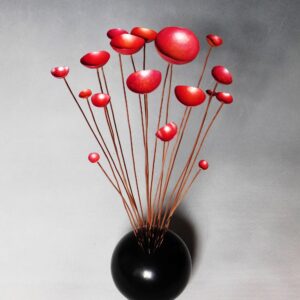
Organically Challenged, 2013.
Recycled lawn bowls, copper, recycled goblets.
Enquiries
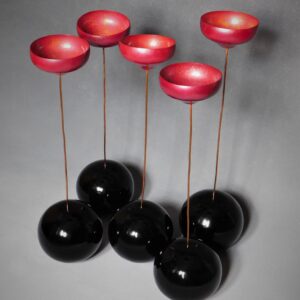
Lawn Weeds, 2013.
Recycled lawn bowls, copper.
Enquiries
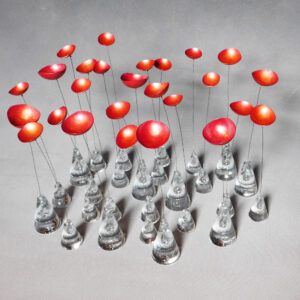
Saplings, 2018.
Copper, stainless steel, sterling silver, recycled glass.
Enquiries
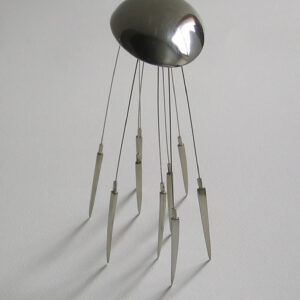
The Walkers, 2012.
Recycled cutlery, stainless steel, sterling silver.
Enquiries
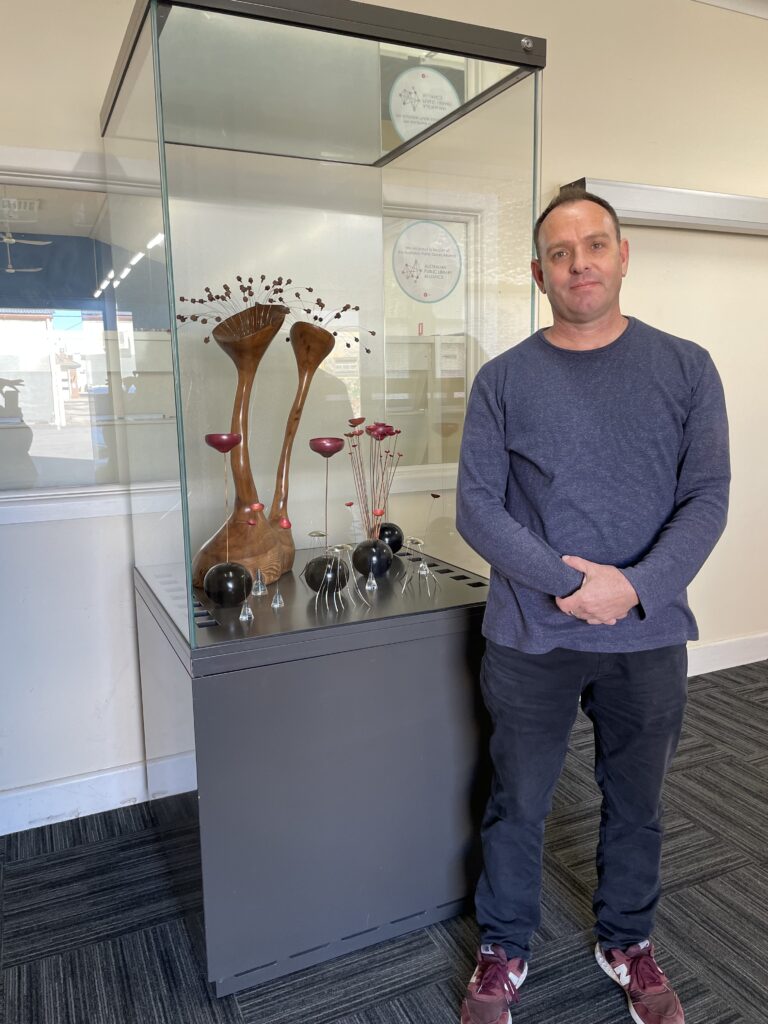
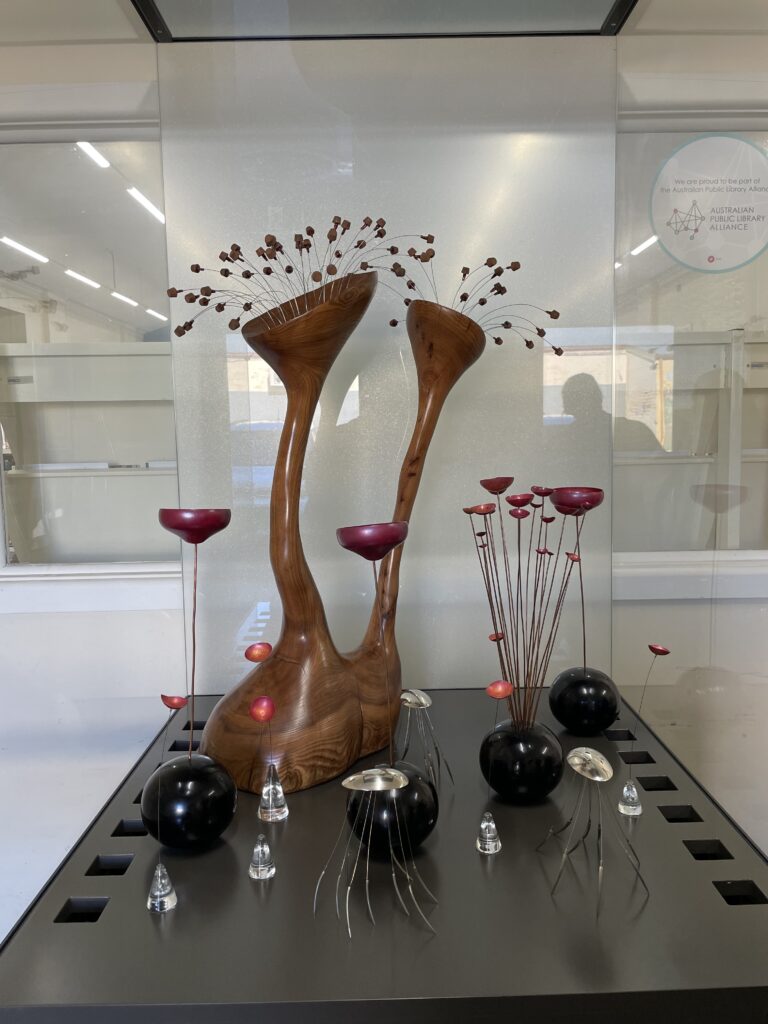
Marquettes by Neil Dickinson
Winter 23
An exhibition of small-scale marquettes or models by Queanbeyan Artist Neil Dickinson.
Neil is a figurative sculptor who created these works as art of the process to larger public sculptures installed in various locations throughout the region.
Neil graduated from the Canberra School of Art in 1983 and received a Postgraduate Diploma (Sculpture) from the University of Tasmania in 1985.
‘Central to my work is a belief in the nobility of the human form and the celebration of the constant struggle with all forms of oppression – the philosophy of inner spiritual growth in the face of materialist aggression.’
With the exception of the marquette of Queen Nellie Hamilton which is still to be realised as a final work, you can find each of the final public works using the interactive map to navigate you there. Each Marquette gives us a unique insight into the Artist’s process and vision during the creation of a major piece.
Works on display are not for sale.
Neil can be contacted about commission work via his social media accounts.
Instagram – @neildickinson.sculptor and Facebook
Nellie’s story – Queen Nellie Hamilton was a Ngunnawal Elder, truth teller and community leader who was born around 1830 at Ginninderra and spent most of her life in the Queanbeyan-Braidwood area. SHe died in 1897 at the Queanbeyan Hospital and is buried outside the Riverside Cemetery. It is hoped that a statue befitting her extraordinary life will help more people hear about her and her story.
The final life size sculpture of Queen Nellie Hamilton is envisioned to be installed within Queanbeyan and will highlight Queanbeyan and the Limestone Plains as Aboriginal places with a rich and ancient history. In the marquette Queen Nellie wears a woollen rug. She is bare footed with her son Eddie and dog Jerrabung by her side.
There are several versions of the following quote of Nellie’s which captures the essence of a Queen.
I no tink much of your law. You come here and take my land, kill my possum, my kangaroo. Leave me starve. Only gib me rotten blanket. Me take calf or sheep, you been shoot me, or put me in jail. You bring your bad sickness ‘mong us.
As recorded in Canberra: Its History and Legends by John Gale, John. Published by A.M. Fallick and Sons. Queanbeyan, 1927.
Find a Neil Dickinson sculpture near you. From the spectacular Queany the Platypus on the Queanbeyan River to the larger-than-life bronze Wombats in Bowral.
Past STA Box Gallery Exhibitions
Woven works by Lisa Stevenson
Summer/Autumn 23
Lisa Stevenson is a Fibre Artist who uses locally harvested natural materials to create beautiful woven works of art.
Many of the works on display were created during Lisa’s Artist in Resindence at the Queanbeyan Hive in early 2023. Read more about Lisa.
Please contact Lisa for sales enquiries on available work.
Follow Lisa on instagram @lisa_went_wondering
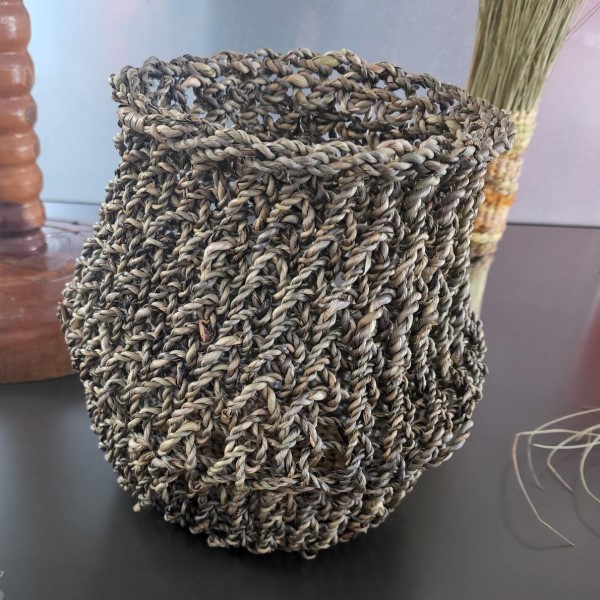
Lisa is the first STA Artist in Residence at the Queanbeyan Hive in January 2023. Read more.

The STA Box Gallery is supported by our partner venue The Q Theatre a cultual serivce of Queanbeyan Palerang Shire Regional Council.
Vist the Q website for upcoming shows and ticket inforation.
STA MEMBERSHIP
free & connects you to the STA universe
Reach out to us
[email protected]
0427 938 110
Or by appointment at one of our
Mobile Office locations
PO Box 1323 Goulburn 2580
ABN 67 208 214 681
We acknowledge Aboriginal people as the traditional custodians of the lands where we create, live & work.
© Southern Tablelands Arts. All Rights Reserved
